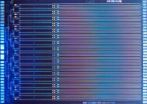(Press-News.org) The new version of the Addiction Severity Index (ASI) gives health professionals the opportunity to design an integral and personalised plan of assistance for patients suffering disorders due to substance abuse.
Developed by the University of Pennsylvania (USA) in the 1980s, the ASI is the most used tool for studying disorders due to substance abuse. After more than 25 years of use, current trends have led ASI creators to update their index and adapt it to the present day reality. The new ASI-6 includes significant structure and content changes in regard to the previous version.
However, as Eva María Díaz-Mesa, a researcher at the Centro de Investigación Biomédica en Red de Salud Mental (CIBERSAM) and author of the study explained to SINC "any assessment test must involve mathematical procedures that determine whether or not it is a valid indicator of a particular psychological conduct."
This study examines the version of the method translated and adapted into Spanish. The study was carried out at 13 centres in Spain, where a total of 258 patients participated, and compiles four periodic assessments that determine the evolution of patients and the ability of the tool to detect changes.
The results, published recently in the journal Psicothema, reveal that the ASI-6 performed well in psychometric terms, that is, "when applied, the tool gives stable measurements (reliability) and actually measures what it intends to (validity)," Díaz Mesa continued. Furthermore, it is worth highlighting the inclusion of smoking and gambling in the assessment, together with caring for children.
The ASI is an interview designed to measure the state of a patient in regard to seven functional domains: alcohol and drug abuse, physical and mental health, employment/resources, family relationships and illegal activity. The scores obtained in the different areas provide information about the severity of the addition (the higher the score the more severe).
Addiction to Legal and Illegal Substances
Although there is widespread social belief that people who consume illegal substances suffer more negative effects, consumption-related health problems are actually primarily due to legal substances.
The World Health Organization (WHO) expected tobacco to explain 16.8% of mortality in Spain, alcohol 3% and illegal drugs 0.6%. However, in regard to the burden of disease, tobacco accounted for 12.3%, alcohol 7.6% and illegal drugs 3.9%.
INFORMATION:
References:
Eva M. Díaz Mesa, Paz García-Portilla, Pilar A. Sáiz, Teresa Bobes Bascarán, María José Casares, Eduardo Fonseca, Eduardo Carreño, Gerardo Flórez, Josep Guardia, Enriqueta Ochoa, César Pereiro, Gabriel Rubio, Antonio Terán, José Ramón Fernández Hermida y Julio Bobes. "Rendimiento psicométrico de la sexta versión del Addiction Severity Index en español (ASI-6)". Psicothema Vol. 22, nº 3, pp. 513-519, agosto de 2010.
Addiction index updated
2010-10-28
ELSE PRESS RELEASES FROM THIS DATE:
Cone of poison: The secret behind the cone snail's venom pump
2010-10-28
Scientists have discovered the secret of how an amazing sea snail injects its venom after shooting a harpoon-like tooth into its prey — or some unlucky swimmer — at jetliner speeds. The creatures, called cone snails, use a highly specialized structure that instantly pumps the paralyzing venom through the tooth and into its target. Their study appears in ACS' monthly Journal of Proteome Research.
Helena Safavi-Hemami, Anthony Purcell and colleagues note that cone snails live mainly in the shallows of the world's tropical oceans. Prized by sea-shell collectors for their ...
Tobacco and its evil cousin, nicotine? They're good -- as a pesticide!
2010-10-28
Tobacco, used on a small scale as a natural organic pesticide for hundreds of years, is getting new scientific attention as a potential mass-produced alternative to traditional commercial pesticides. That's the topic of a report in ACS' bi-weekly journal Industrial & Engineering Chemistry Research.
Cedric Briens and colleagues note that concerns about the health risks of tobacco have reduced demand and hurt tobacco farmers in some parts of the world. Scientists are looking for new uses for tobacco. One potential use is as a natural pesticide, due to tobacco's content ...
Small particles show big promise in beating unpleasant odors
2010-10-28
Scientists are reporting development of a new approach for dealing with offensive household and other odors — one that doesn't simply mask odors like today's room fresheners, but eliminates them at the source. Their research found that a deodorant made from nanoparticles — hundreds of times smaller than peach fuzz — eliminates odors up to twice as effectively as today's gold standard. A report on these next-generation odor-fighters appears in ACS' Langmuir, a bi-weekly journal.
Brij Moudgil and colleagues note that consumers use a wide range of materials to battle undesirable ...
From touchpad to thought-pad?
2010-10-28
Move over, touchpad screens: New research funded in part by the National Institutes of Health shows that it is possible to manipulate complex visual images on a computer screen using only the mind.
The study, published in Nature, found that when research subjects had their brains connected to a computer displaying two merged images, they could force the computer to display one of the images and discard the other. The signals transmitted from each subject's brain to the computer were derived from just a handful of brain cells.
"The subjects were able to use their thoughts ...
Probing the mysterious second-wave of damage in head injury patients
2010-10-28
Why do some of the one million people who sustain head injuries annually in United States experience a mysterious second wave of brain damage days after the initial injury — just when they appear to be recovering? Limited clinical trials using an innovative new device to monitor brain chemistry on a second-by-second basis are underway to answer that life-and-death question, according to an article in the current issue of Chemical & Engineering News (C&EN), ACS' weekly newsmagazine. Brain injury is the leading cause of death and disability worldwide.
C&EN Senior Editor ...
Concerns about the safety of certain 'healthful' plant-based antioxidants
2010-10-28
Scientists are calling for more research on the possibility that some supposedly healthful plant-based antioxidants — including those renowned for their apparent ability to prevent cancer — may actually aggravate or even cause cancer in some individuals. Their recommendation follows a study in which two such antioxidants — quercetin and ferulic acid — appeared to aggravate kidney cancer in severely diabetic laboratory rats. The study appears in ACS' bi-weekly Journal of Agricultural and Food Chemistry.
Kuan-Chou Chen, Robert Peng, and colleagues note that vegetables, ...
NIST ships first programmable AC/DC 10-volt standard
2010-10-28
Extending its 26-year tradition of innovative quantum voltage standards, researchers at the National Institute of Standards and Technology (NIST) have begun shipping a new 10-volt standard to users around the world. The programmable system measures both direct current (DC) and alternating current (AC) voltages.
NIST AC/DC 10-volt standard chip.
The new 10-volt system* builds on a number of previous NIST inventions, from the initial 1-volt standard in 1984 through the 2006 unveiling of the world's first precision instrument for directly measuring AC voltages.** Because ...
Canada needs to improve end-of-life care
2010-10-28
Better psychological and spiritual support, improved planning of care and stronger relationships with physicians are necessary to improve end-of-life care in Canada, according to a study by a Queen's University professor.
"High quality end-of-life care should be the right of every Canadian," says professor of Medicine and Epidemiology Daren Heyland, who is also a researcher at Kingston General Hospital. "But it's not always happening. We know from international studies that Canada ranks ninth in the world in terms of quality of care provided at the end of life."
The study, ...
'Sí' on the new SI: NIST backs proposal for a revamped system of measurement units
2010-10-28
Taking the first steps of what would be a major historical advance in the science of measurement, the National Institute of Standards and Technology (NIST) is participating in a worldwide effort to recommend major revisions to the International System of Units (SI), the modern metric system that is the basis of global measurements in commerce, science and other aspects of everyday life. The new SI, which would be based on seven constants of nature, would enable researchers around the world to express the results of measurements at new levels of consistency and accuracy.
The ...
New software eases analysis of insect in motion
2010-10-28
Cockroaches can skitter through a crowded under-the-sink cabinet, eluding capture or worse, making the insects a model for rescue robots that would creep through the debris of disaster in search of survivors.
But learning how they use all six legs at the same time to walk, run and turn has been a difficult and time-consuming task. Until now.
Using a pair of high-speed cameras and a custom computer program, researchers at Case Western Reserve University are able to simultaneously extract three-dimensional movement of a cockroach's 26 leg joints. They report their findings ...


